Discover 11 hidden attractions, cool sights, and unusual things to do in Staines-upon-Thames (United Kingdom). Don't miss out on these must-see attractions: St. Mary's Church, Staines Bridge, and Staines Railway Bridge. Also, be sure to include Hollyhock Island in your itinerary.
Below, you can find the list of the most amazing places you should visit in Staines-upon-Thames (England).
Table of Contents
St. Mary's Church
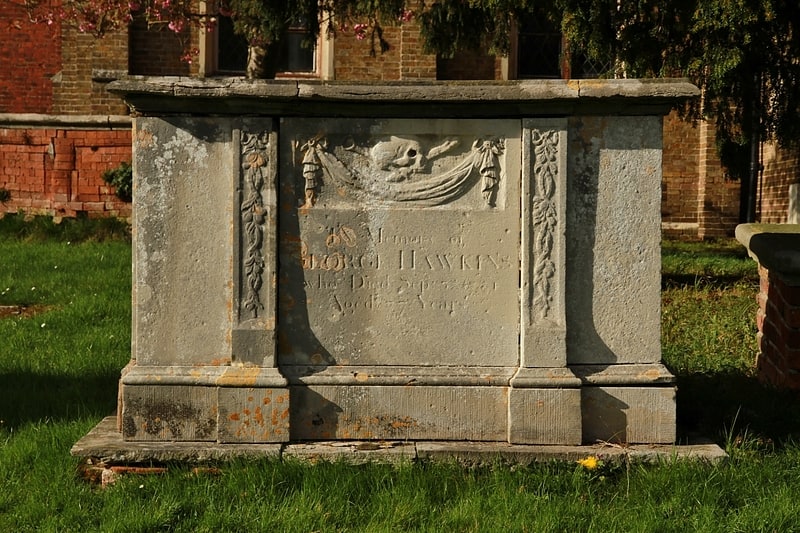
Church in Staines, England. St Mary's, Staines, is a Church of England parish church in the town and parish of Staines-upon-Thames, in the Spelthorne borough of Surrey and the Greater London Urban Area. The parish is in the Archdeaconry of Middlesex in the Diocese of London. The church building is on an unusual rise against the Thames at the west end of the town. It has been a Grade II* listed building since 11 August 1952.[1]
Staines Bridge
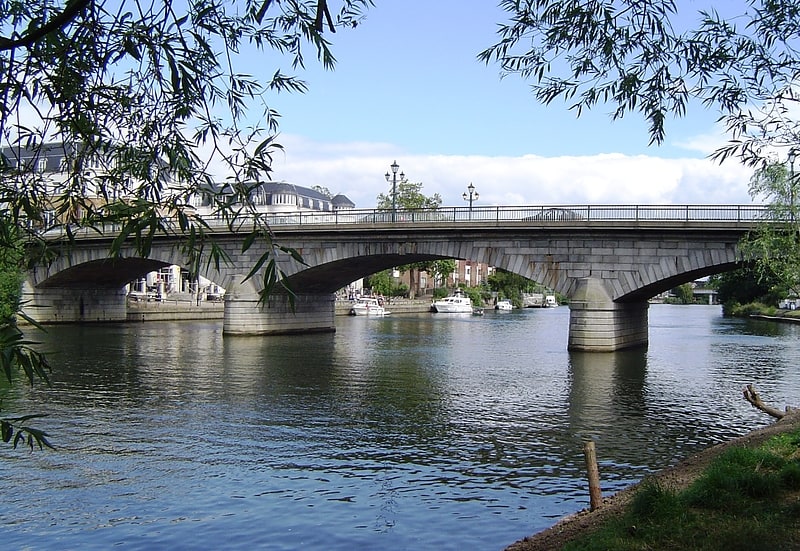
Bridge in Staines, England. Staines Bridge is a road bridge running in a south-west to north-east direction across the River Thames in Surrey. It is on the modern A308 road and links the boroughs of Spelthorne and Runnymede at Staines-upon-Thames and Egham Hythe. The bridge is Grade II listed.
The bridge crosses the Thames on the reach between Penton Hook Lock and Bell Weir Lock, and is close to and upstream of the main mouth of the River Colne, a tributary. The bridge carries the Thames Path across the river.
Its forebear built in Roman Britain, the bridge has been bypassed by three arterial routes, firstly in 1961 by the Runnymede Bridge near Wraysbury and in the 1970s by the building of the UK motorway network (specifically near Maidenhead and Chertsey). Owing to the commercial centres of the town in Spelthorne and of Egham, the bridge has had peak hour queues since at least the 1930s.[2]
Address: Staines Bridge, T W18 Staines
Staines Railway Bridge
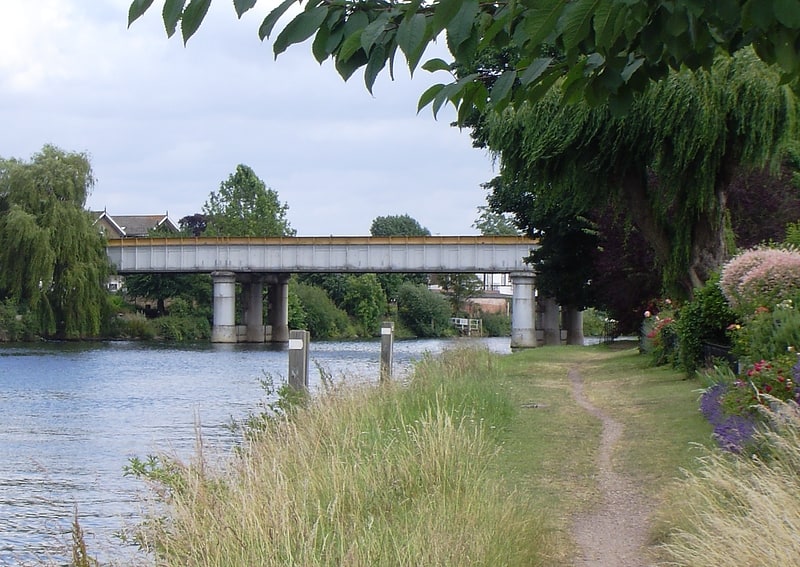
Bridge in Staines, England. Staines Railway Bridge carries the Waterloo to Reading Line across the Thames in England.[3]
Hollyhock Island
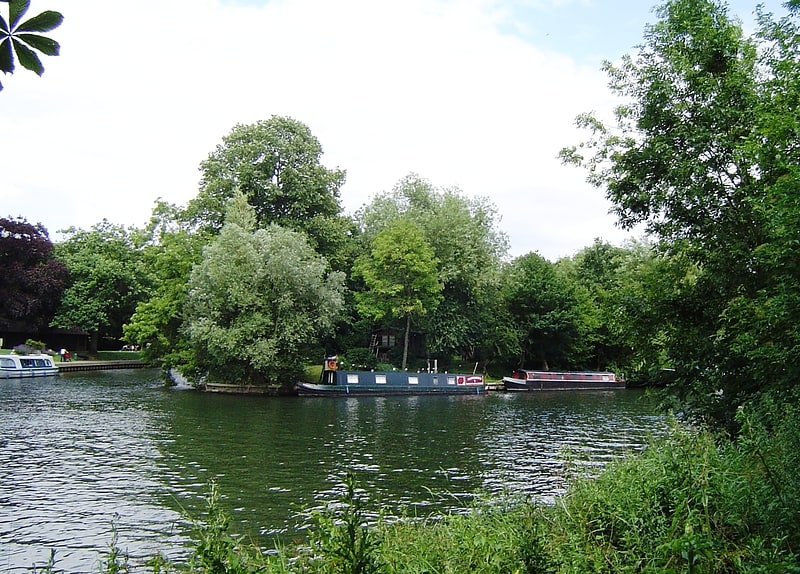
Island in Staines, England. Hollyhock Island is an inhabited island in the River Thames in England on the reach between Bell Weir Lock and Penton Hook Lock.[4]
Church Island
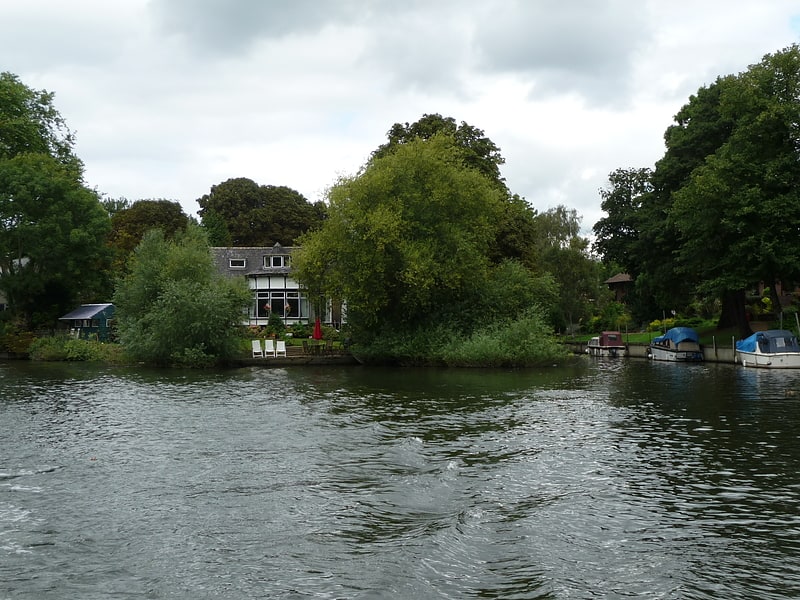
Island in Staines, England. Church Island or Church Eyot is an inhabited island in the River Thames in England on the reach above Penton Hook Lock in Staines-upon-Thames, Spelthorne, Surrey. It is in the upper part of the reach. It is approximately 200 m above Staines Bridge, but is thought by some historians to have been the site of the Roman bridges across the Thames recorded as a waypoint on the Devil's Highway between Londinium and Calleva.[5]
Penton Hook Island

Island. Penton Hook Island is a mainly wooded former peninsula created into a series of three weir-divided islands in the River Thames in England, so created in river modifications since 1815 with a navigable lock and weir stream channel to form meander cutoffs. It has a lock and weirs that are the divide between the Laleham Reach, above Chertsey Lock and Staines Reach, above Penton Hook Lock.[6]
Penton Hook Lock
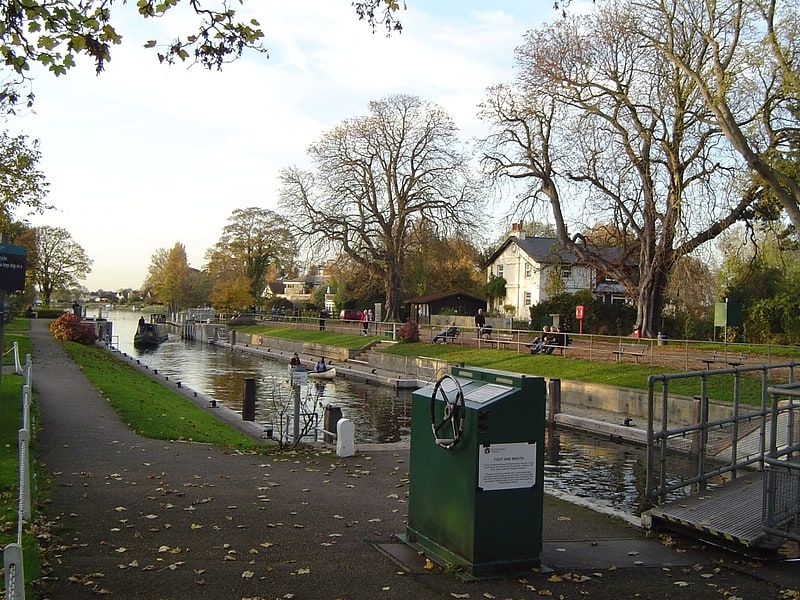
Penton Hook Lock is the sixth lowest lock of forty four on the non-tidal reaches of the River Thames in England. It faces an island which was until its construction a pronounced meander and is on the site of its seasonal cutoff. It is against the left bank marking the church parish medieval border of Laleham and Staines upon Thames in Surrey for many centuries. Until 1965 their county was Middlesex. At 266 ft it is the third longest lock on the river.
A bend 900 m upstream of the lock, Silvery Sands, hosts Staines Regatta in the sport of rowing annually. On the opposite bank in Thorpe is Penton Hook Marina which occupies lakes once land used for gravel extraction.[7]
Address: Thames Side, Staines-upon-Thames
Staines Reservoirs
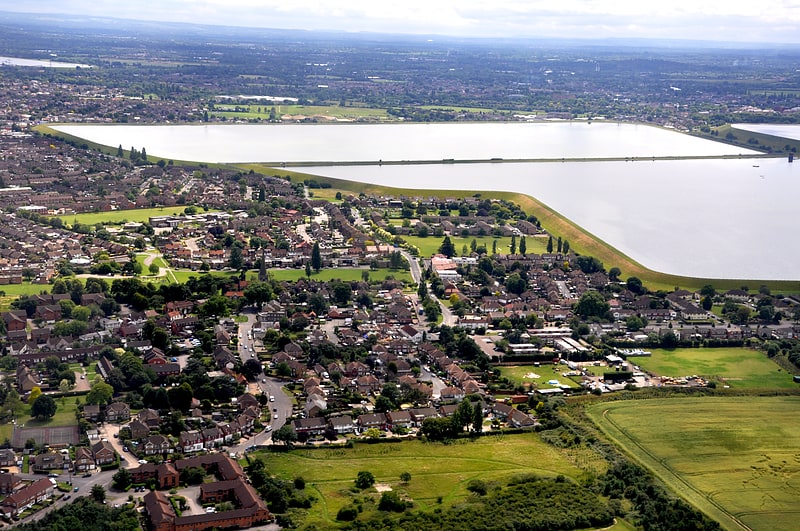
Reservoir in England. The Staines Reservoirs are two large pumped storage reservoirs sitting to the east of the King George VI Reservoir near Heathrow airport in Surrey within the Colne Valley regional park. The village of Stanwell is mainly to the north east, and the town of Staines is to the south.
Both adjoin, west, the A3044. The south one adjoins the A30 where the road is bypassed by the intra-M25 motorway network but is a trunk road, maintained by Highways England. They were completed in 1902.[8]
Truss's Island
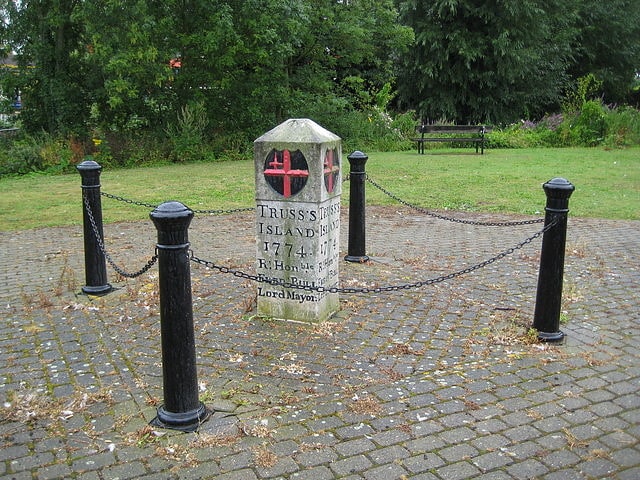
Island in England. Truss's Island is a small island in the River Thames in England, between Staines-upon-Thames and Laleham. The uninhabited island is publicly accessible across two footbridges from the right bank of the Thames and is landscaped with grass, trees and shrubs.[9]
King George VI Reservoir

Reservoir in England. The King George VI Reservoir sits between Stanwell Moor and Staines upon Thames, south-west of Heathrow, England. It is between Staines Moor and a north–south road abutting the Staines Reservoirs. The reservoir was opened in November 1947 and named after the then reigning monarch George VI. It is owned by Thames Water.[10]
Thorpe Hay Meadow

Park in Woking, England. Thorpe Hay Meadow is a 6.4-hectare biological Site of Special Scientific Interest west of Staines-upon-Thames in Surrey. It is owned and managed by the Surrey Wildlife Trust.
Its habitat is (acid-alkali) neutral grassland and it contains Cynosurus cristatus - Centaurea nigra grassland as a notified feature.
The site is thought to be the last remaining example of a Thames valley hay meadow in Surrey. It contains a range of lime-loving (calcicole) plants which are characteristic of this type of meadow. The grassland is dominated by rough-stalked meadow grass Poa trivialis, crested dog’s-tail grass Cynosurus cristatus, and lesser knapweed Centaurea nigra. Yellow rattle Rhinanthus minor, meadow-fescue grass Festuca pratensis, meadow barley Hordeum secalinum, smooth hawk’s-beard Crepis capillaris and common reed Phragmites australis are locally abundant, the last species being unusual in such dry situations. Other frequent species include meadow brome Bromus commutatus, a grass only recorded from one other Surrey location in recent years, meadow foxtail grass Alopecurus pratensis, Yorkshire-fog grass Holcus lanatus, pepper saxifrage Silaum silaus and meadow-sweet Filipendula ulmaria. Associated calcicole species include meadow cranesbill Geranium pratense, clustered bell-flower Campanula glomerata, cowslip Primula veris, hoary plantain Plantago media, salad burnet Sanguisorba minor and lady’s bedstraw Galium verum.
The meadow is surrounded by old hedgerows with a variety of species such as ash Fraxinus excelsior, hawthorn Crataegus monogyna, field maple Acer campestre, spindle Euonymus europaeus, dogwood Cornus sanguinea, and buckthorn Rhamnus catharticus. A drainage ditch along two sides of the site supports five species of willow including purple willow Salix purpurea and almond willow Salix triandra. Common comfrey Symphytum officinale, ragged robin Lychnis flos-cuculi, cyperus sedge Carex pseudocyperus and the uncommon aquatic liverwort Riccia fluitans...along this ditch.
A footpath from Staines passes through the site.[11]